
Year 1523 (MDXXIII) was a common year starting on Thursday of the Julian calendar.

The House of Bourbon is a dynasty that originated in the Kingdom of France as a branch of the Capetian dynasty, the royal House of France. Bourbon kings first ruled France and Navarre in the 16th century. A branch descended from the French Bourbons came to rule Spain in the 18th century and is the current Spanish royal family. Further branches, descended from the Spanish Bourbons, held thrones in Naples, Sicily, and Parma. Today, Spain and Luxembourg have monarchs of the House of Bourbon. The royal Bourbons originated in 1272, when Robert, the youngest son of King Louis IX of France, married the heiress of the lordship of Bourbon. The house continued for three centuries as a cadet branch, serving as nobles under the direct Capetian and Valois kings.

Charles V was Holy Roman Emperor and Archduke of Austria from 1519 to 1556, King of Spain from 1516 to 1556, and Lord of the Netherlands as titular Duke of Burgundy from 1506 to 1555. He was heir to and then head of the rising House of Habsburg. His dominions in Europe included the Holy Roman Empire, extending from Germany to northern Italy with rule over the Austrian hereditary lands and Burgundian Low Countries, and Spain with its possessions of the southern Italian kingdoms of Naples, Sicily and Sardinia. In the Americas, he oversaw the continuation of Spanish colonization and a short-lived German colonization. The personal union of the European and American territories he ruled was the first collection of realms labelled "the empire on which the sun never sets".

The Battle of Pavia, fought on the morning of 24 February 1525, was the decisive engagement of the Italian War of 1521–1526 between the Kingdom of France and the Habsburg Empire of Charles V, Holy Roman Emperor as well as ruler of Spain, Austria, the Low Countries, and the Two Sicilies.
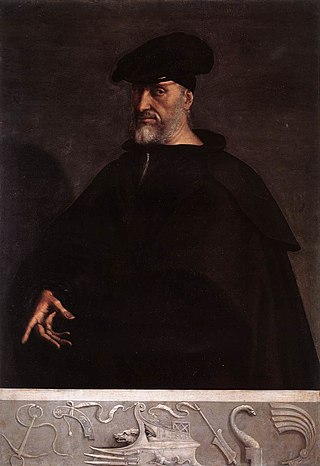
Andrea Doria, Prince of Melfi was a Genoese statesman, condottiero, and admiral, who played a key role in the Republic of Genoa during his lifetime.
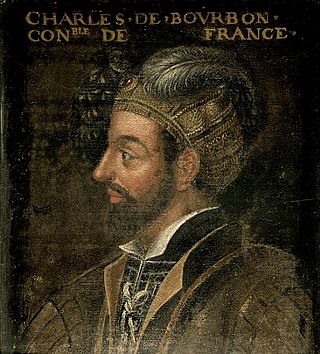
Charles III, Duke of Bourbon was a French military leader, the count of Montpensier, Clermont and Auvergne, and dauphin of Auvergne from 1501 to 1523, then duke of Bourbon and Auvergne, count of Clermont-en-Beauvaisis, Forez and La Marche, and lord of Beaujeu from 1505 to 1521. He was also the constable of France from 1515 to 1521. Also known as the Constable of Bourbon, he was the last of the great feudal lords to oppose the king of France. He commanded the troops of Holy Roman Emperor Charles V in what became known as the Sack of Rome in 1527, where he was killed.
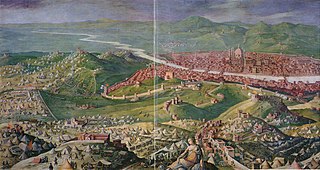
The War of the League of Cognac (1526–30) was fought between the Habsburg dominions of Charles V—primarily the Holy Roman Empire and Spain—and the League of Cognac, an alliance including the Kingdom of France, Pope Clement VII, the Republic of Venice, the Kingdom of England, the Duchy of Milan, and the Republic of Florence.

The Italian War of 1521–1526, sometimes known as the Four Years' War, was a part of the Italian Wars. The war pitted Francis I of France and the Republic of Venice against the Holy Roman Emperor Charles V, Henry VIII of England, and the Papal States. It arose from animosity over the election of Charles as Emperor in 1519–1520 and from Pope Leo X's need to ally with Charles against Martin Luther.
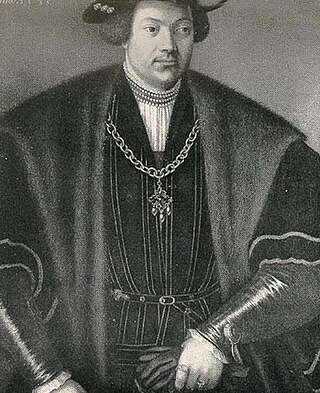
Gabriel von Salamanca was a Spanish nobleman who served as general treasurer and archchancellor of the Habsburg archduke Ferdinand I of Austria from 1521 to 1526. He was elevated to a Count of Ortenburg in 1524.

Honoré I or Onorato I was Lord of Monaco from 22 August 1523 to 7 October 1581.
Lamberto Grimaldi was Lord of Monaco from 16 March 1458. He was married to his seventh cousin Claudine Grimaldi in 1465, per the wishes and legal Will and testament of her late brother, Catalan, and their father. Lamberto was of the branch of the Grimaldi family which had settled in Antibes while Claudine was of the more powerful Monaco branch. Grimaldi had one brother, Jean-André, in the church and another brother, Louis, in the military. Grimaldi found much help and support as a ruler from his brothers and, following his feud with the faction headed by Claudine's mother, Pomellina Fregoso, Lambert secured his title and an "oath of fidelity" from the population of Monaco. His marriage to Claudine ensured the continuity of Monaco's rule by a Grimaldi. Claudine was nominally her brother's successor, but all power as Seigneur of Monaco was in her husband's hands and their marriage legitimized the succession for their descendants. The succession was legally secured to the children of Lamberto and Claudine, in order of birth, on August 14, 1483. This new succession act was actually just a confirmation of the decrees drawn up by Claudine's father and brother. If only female offspring would survive, then it was decreed that such female offspring must marry a Grimaldi in order to inherit the throne.

The Prince's Palace of Monaco is the official residence of the Sovereign Prince of Monaco. Built in 1191 as a Genoese fortress, during its long and often dramatic history it has been bombarded and besieged by many foreign powers. Since the end of the 13th century, it has been the stronghold and home of the Grimaldi family who first captured it in 1297. The Grimaldi ruled the area first as feudal lords, and from the 17th century as sovereign princes, but their power was often derived from fragile agreements with their larger and stronger neighbours.

Lucien became Lord of Monaco on 11 October 1505, having murdered his predecessor and brother, Jean II, and held that sovereignty until his death.
Augustine Grimaldi was Regent of Monaco (1523–1532), Bishop of Grasse, Abbot of Lérins, and founder of the village of Valbonne.

Claudine or Claudia was Lady regnant of Monaco between 1457 and 1458, and the Lady consort of Monaco by marriage to Lord Lambert of Monaco.
The Battle of Landriano took place on 21 June 1529, between the French army under Francis de Bourbon, Comte de St. Pol and the Imperial–Spanish army commanded by Don Antonio de Leyva, Duke of Terranova in the context of the War of the League of Cognac. The French army was destroyed and the battle's strategic result was that the struggle between Francis I of France and Charles V, Holy Roman Emperor for control of northern Italy was temporarily at an end.
Jeanne de Pontevès-Cabanes , was Lady of Monaco by marriage to Lucien, Lord of Monaco.

Cornelis de Schepper, Cornelis Duplicius de Schepper or Cornelius de Schepper (1503?-1555) was a Flemish mathematician, counselor and ambassador for the Holy Roman Emperor Charles V, Ferdinand I of Austria and Mary of Hungary, governor of the Netherlands. He is also known by his Latin name Scepperus.

The Empire of Charles V, also known by the umbrella term Habsburg Empire, included the Holy Roman Empire, the Spanish empire, the Burgundian Low Countries, the Austrian lands, and all the territories and dominions ruled in personal union by Charles V from 1519 to 1556. It was the first to be labelled as "the empire on which the sun never sets", a term used to describe several global empires throughout history. The lands of the empire had in common only the monarch, Charles V, while their boundaries, institutions, and laws remained distinct. Charles's nomenclature as Holy Roman Emperor was Charles V, though earlier in his life he was known by the names of Charles of Ghent, Charles II as Duke of Burgundy, and Charles I as King of Spain and Archduke of Austria. The imperial name prevailed due to the politico-religious primacy held by the Holy Roman Empire among European monarchies since the Middle Ages, which Charles V intended to preserve as part of his project to unite Christendom under his leadership.
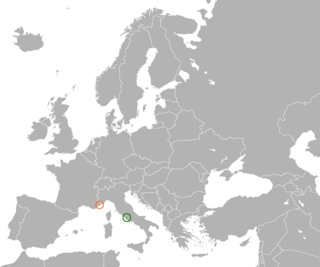
Holy See–Monaco relations are bilateral relations between the Principality of Monaco and the Holy See. The principal Monégasque official is Ambassador Claude Giordan, who officially started at his position in November 2015. The Holy See is represented by its Apostolic Nuncio, Archbishop Antonio Arcari, who assumed office on May 25, 2019. The Embassy of Monaco to the Holy See is located in Rome, on Largo Spinelli. The Apostolic Nunciature to Monaco is non-residing as the nuncio currently resides in Rome.

















